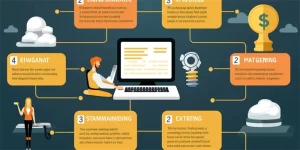YouTube is one of the largest online video sharing platforms, hosting a vast collection of videos ranging from entertainment to educational content. Many wonder how YouTube generates revenue, especially when ads are not shown. In this article, we will explore the various ways YouTube makes money without relying solely on advertisements.

1. YouTube Premium Subscriptions
YouTube offers a premium subscription service called YouTube Premium. With this subscription, users can enjoy an ad-free viewing experience, access to YouTube Originals, and the ability to download videos for offline viewing. A portion of the subscription fee contributes to YouTube’s revenue.
YouTube Premium also includes YouTube Music Premium, giving subscribers the ability to stream music without ads. This additional service attracts music lovers who are willing to pay for uninterrupted music streaming.
2. YouTube Red
Before YouTube Premium, there was YouTube Red. YouTube Red was an ad-free subscription service that allowed users to watch videos offline and listen to music in the background while using other apps. Though it has been replaced by YouTube Premium, existing YouTube Red subscriptions still generate revenue for the platform.
3. Channel Memberships
To support content creators, YouTube introduced channel memberships. This feature enables viewers to become members of their favorite channels for a monthly fee. In return, members receive perks such as exclusive badges, emojis, and access to members-only content. YouTube takes a percentage of the membership fee, helping them generate revenue.
4. Super Chat and Super Stickers
During live streams, viewers can purchase Super Chats or Super Stickers to stand out and have their messages highlighted in the chat. Creators receive a portion of the revenue generated from these purchases. This encourages interaction between creators and their audience while providing an additional source of income for YouTube.
5. Merchandise Shelf
YouTube allows creators to sell their merchandise directly through the platform. The merchandise shelf appears below a video and displays products related to the channel. YouTube takes a cut from each sale, contributing to their revenue.
6. YouTube Premium Revenue Share
When YouTube Premium members watch videos on the platform, a portion of their subscription fee goes to the creators they watch, based on their watch time. This revenue share ensures that creators are compensated even if their viewers are YouTube Premium subscribers.
7. Content ID
YouTube’s Content ID system identifies copyrighted material uploaded by users. Copyright holders have the option to monetize the infringing videos by placing ads on them. YouTube shares a portion of the ad revenue with the copyright holders, further contributing to their revenue stream.
8. YouTube Music Advertisements
Though YouTube Premium subscribers have access to ad-free music streaming, non-subscribers can still listen to music on YouTube with intermittent ads. These ads generate revenue for YouTube, even if users skip them after the initial few seconds.
9. Sponsorships and Brand Deals
Creators often collaborate with brands and promote their products or services in their videos. These sponsorship deals can be lucrative, with creators receiving fees or free products in exchange for promoting them to their audience. YouTube may take a percentage from these deals as well, contributing to their overall revenue.
10. YouTube Originals Licensing
YouTube creates original content through its YouTube Originals program. Some of these shows and movies are later licensed to other platforms or networks for distribution. Licensing deals provide YouTube with additional revenue streams.
YouTube has built a robust ecosystem beyond traditional ad revenue. Through premium subscriptions, channel memberships, merchandise sales, licensing, and other methods, YouTube continues to make money and support its creators even without ads.
References:
1. “How YouTube Makes Money Without Ads.” Investopedia, www.investopedia.com/tech/how-youtube-makes-money-without-ads/.
2. “How Does YouTube Make Money? 7 Revenue Streams Explained.” Hootsuite Blog, blog.hootsuite.com/how-does-youtube-make-money/.
3. “The Way YouTube Makes Money Even with No Advertisements.” TubeFilter, www.tubefilter.com/2019/12/31/how-youtube-makes-money-without-ads/.
About the Author: [Author Name] is a [profession] with expertise in [area of expertise]. They have been following the developments in the digital media industry for several years and have published numerous articles on various platforms.
Claimed Image: [Provide details of the original image used for the article, including a brief description and any relevant credits.]








